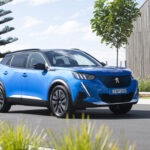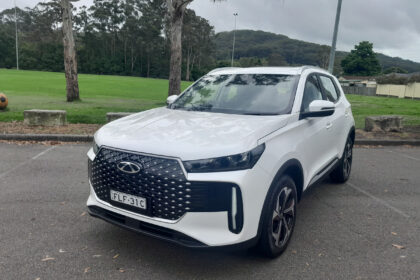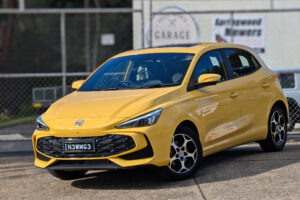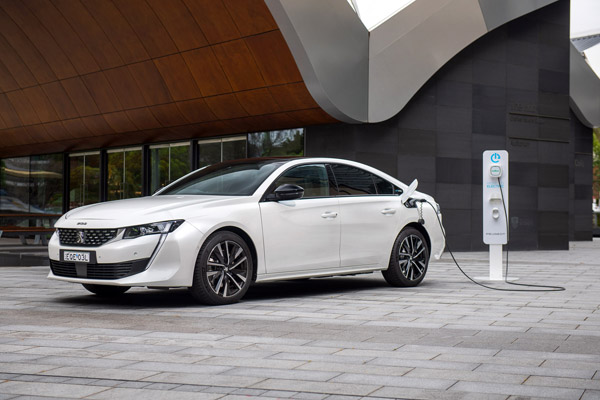
The 508 GT Plug-in Hybrid is now offered by the French marque in Australia.
STYLING
It’s chic and sleek, sitting long and low with frameless door windows and coupe-like
liftback. To say it’s eye-catching doesn’t do the car justice. It’s almost a work of art. The
inside is a study in design too.
The windscreen is cluttered and the chunky A pillar blocks driver vision at critical
moments, for example on roundabouts. Over the shoulder vision is not terrific either, with
even larger rear pillars and limited vision from the rear window.
Metallic paint is another $690, premium paint adds $1050, and if you fancy a sunroof —
that’s a $2500 option.
You might be enticed to pay $60K for a 508, but by the time you add on-roads $85K for a
hybrid that will travel a maximum of 55km under electric power alone. As such, we don’t
see Peugeot selling many.
Standard kit includes double-stitched Nappa leather, two-zone climate air with rear outlets
as well as a dust and pollen filter, power adjust front seats with massage and Focal 10-
speaker premium audio.
There are 18-inch alloys (turbo gets 19s), configurable 12.3-inch digital instrument panel,
LED headlights and daytime-running lights, LED interior lighting and park assist (parallel
and perpendicular), along with a power release boot lid.
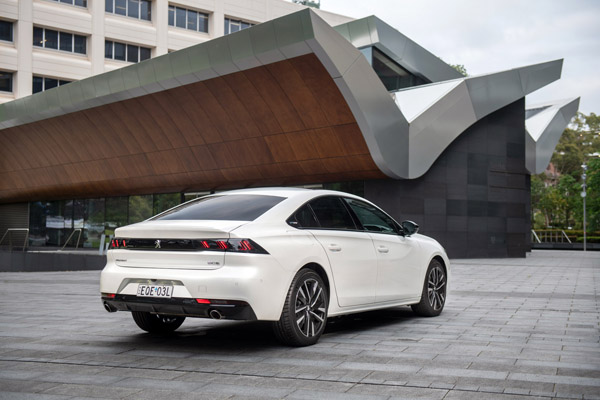
Peugeot 508 is covered by a 5-year/unlimited-kilometre warranty with five years of
roadside assistance, plus an eight-year/160,000km battery warranty.
INFOTAINMENT
It has a 10.0-inch high-definition touchscreen, with Bluetooth, navigation, digital radio,
Apple CarPlay, Android Auto and Mirror Screen.
The Focal system pumps out 515 Watts, with 10 speakers including a dedicated amplifier
and subwoofer, plus two 12V sockets (dashboard and load area) and four USB Sockets (2
x front centre console, 2 x rear centre console).
ENGINES / TRANSMISSIONS
The hybrid puts out 165kW torque is 360Nm. The 1.6 PureTech engine is paired an eight-
speed automatic.
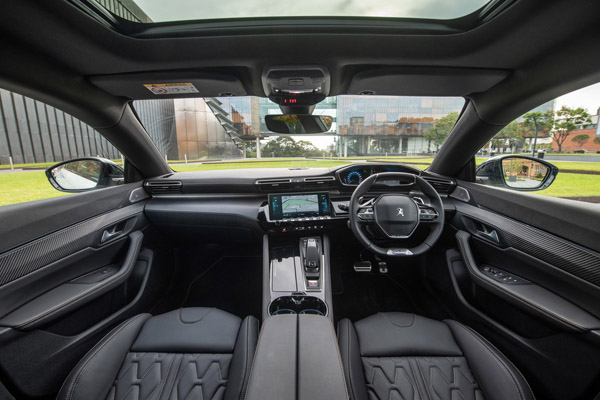
SAFETY
The 508 has six airbags, 180-degree rear-view camera and autonomous emergency
braking (city, interurban and vulnerable road user).
There’s active blind spot detection, active lane keeping assistance, automatic high beam
and speed sign recognition and recommendation. But it misses out on rear cross-traffic
alert.
DRIVING
Fuel consumption for the turbo is 5.5L/100km. The hybrid with a smaller 43-litre tank is
rated at 1.8L/100km.
With an 11.8kWh battery capacity, the hybrid offers an electric only driving range of up to
55km (WLTP), which is probable enough for the daily commute.
There are four driving modes: Electric, Hybrid, Sport and Comfort.
Electric speaks for itself, while hybrid mode allows the driver to use the most efficient
combination of electric or internal combustion engine depending on driving style and type
of road.
You can also recover energy from braking by selecting the B setting instead of Drive. In
this setting the car begins to brake as soon as you lift off the accelerator. It won’t bring the
car to a halt, but with a little practice you can avoid using the brake pedal 90 per cent of
the time.
e-SAVE allows the driver to bank reclaimed power or use it straight away for improved
performance.
Peugeot recommends regularly charging the battery to 100 per cent to experience the
benefits of its electric capabilities.
Charging from zero to 100 percent takes about five hours via a 2.3kW Mode 2 cable.
You can charge using a standard powerpoint, home charger or commercial fast charger,
but there’s not a lot of point forking out for a commercial charger because the charge rate
is limited to 3.7kW – barely more than a powerpoint can provide.
Getting into the 508 for the first time, the cabin and driver’s seat feel a little cramped.
Though good, the ride quality is not as good as the car we drove previously, despite being
fitted with adaptive dampers.
Peugeot has championed its head-up dash layout which puts the instrument panel above
the steering wheel, directing the driver’s line of sight over the wheel rather than through it.
But sitting there playing with the adjustment of the wheel it doesn’t look that elevated these
days and, as someone who likes the wheel set high, pushing it up obscures the dials.
These same designers want me to look down at the central touchscreen rather than up,
because the screen remains built into the dash rather than sitting on top of it as is the
vogue.
While there’s a physical volume button and a row of piano style keys immediately
underneath that provide quick access to various functions, the temperature controls are
digital and flank either side of the screen.
You’d think they would be designed to disappear when reverse is engaged, devoting
maximum real estate to the camera. Alas, this is not the case. In fact, it gets worse when
the overhead simulation kicks in, reducing the size of the camera even further, making it
difficult to see, especially at night.
The dash can also be affected by glare because the steeply-raked windscreen extends
beyond it.
The design of the car actually dates back to 2019, pre-dating wireless charging.
Looking for USB ports? You’ll find two in the front in a hidey hole below the centre console.
There’s another two in the back below the rear air vents. There’s a 12-volt outlet in the
centre console.
We enjoyed driving the 508. The transmission can lag, frustratingly so in manual mode,
often leading to double changes.
Ride and handling are excellent, but it’s more of a touring car than a sports machine.
We chose not to recharge the battery, setting it to hybrid mode to see how it performed
with and without electric help. The car was showing 6.0L/100km by the time we got it
home and 6.7L/100km on its return.
SUMMING UP
It’s too expensive. If it was us and we just had to have one, we’d save our pennies and pop
for the non-hybrid version. The $18,000 you pocket will pay for a lot of premium
unleaded…
Hats off to Peugeot for having a red-hot go, however. Liberté, égalité, fraternité. Vive la
révolution.
RATINGS:
Looks: 8/10
Performance: 7.5/10
Safety: 7.5/10
Thirst: 8/10
Practicality: 7/10
Comfort: 7.5/10
Tech: 8/10
Value: 6/10
Overall: 7.4/10
AT A GLANCE
MODEL RANGE
508 1.6 GT Fastback: $63,431
508 1.6 GT PHEV Fastback: $81,610
508 1.6 GT Sportswagon: $65,657
Note: These prices do not include government or dealer delivery charges. Contact your
local Peugeot dealer for drive-away prices.
SPECIFICATIONS (Peugeot 508 1.6-litre turbo-petrol four-door sedan)
ENGINE:
Capacity: 1.6 litres
Configuration: Four cylinders in line
Maximum Power: 165 kW @ 6000 rpm
Maximum Torque: 360 Nm @ 2750 rpm
Fuel Type: Premium unleaded petrol
Combined Fuel Cycle (ADR 81/02): 1.8 L/100km
CO2 Emissions: 40 g/km
DRIVELINE:
Eight-speed automatic, front-wheel drive
DIMENSIONS, WEIGHT AND CAPACITIES:
Length: 4750 mm
Wheelbase: 2800 mm
Width: 1860 mm
Height: 1410 mm
Turning Circle: 10.8 metres
Kerb Mass: 1720 kg
Fuel Tank Capacity: 43 litres
BRAKES:
Front: Ventilated disc
Rear: Solid disc
STANDARD WARRANTY:
Five years / unlimited kilometres





